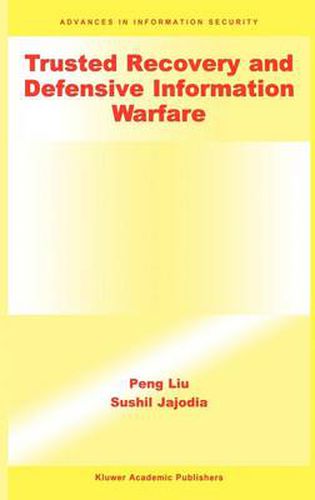Readings Newsletter
Become a Readings Member to make your shopping experience even easier.
Sign in or sign up for free!
You’re not far away from qualifying for FREE standard shipping within Australia
You’ve qualified for FREE standard shipping within Australia
The cart is loading…






This title is printed to order. This book may have been self-published. If so, we cannot guarantee the quality of the content. In the main most books will have gone through the editing process however some may not. We therefore suggest that you be aware of this before ordering this book. If in doubt check either the author or publisher’s details as we are unable to accept any returns unless they are faulty. Please contact us if you have any questions.
Information security concerns the confidentiality, integrity, and availability of information processed by a computer system. With an emphasis on prevention, traditional information security research has focused little on the ability to survive successful attacks, which can seriously impair the integrity and availability of a system. This text uses database trusted recovery, as an example, to illustrate the principles of trusted recovery in defensive information warfare. Traditional database recovery mechanisms do not address trusted recovery, except for complete rollbacks, which undo the work of benign transactions as well as malicious ones, and compensating transactions, whose utility depends on application semantics. Database trusted recovery faces a set of unique challenges. In particular, trusted database recovery is complicated mainly by the presence of benign transactions that depend, directly or indirectly on malicious transactions and the requirement by many mission-critical database applications that trusted recovery should be done on-the-fly without blocking the execution of new user transactions. This book proposes an alternative model and a set of innovative algorithms for database trusted recovery. Both read-write dependency-based and semantics-based trusted recovery algorithms are proposed, together with static and dynamic database trusted recovery algorithms. These algorithms can typically save a lot of work by innocent users and can satisfy a variety of attack recovery requirements of real world database applications.
$9.00 standard shipping within Australia
FREE standard shipping within Australia for orders over $100.00
Express & International shipping calculated at checkout
This title is printed to order. This book may have been self-published. If so, we cannot guarantee the quality of the content. In the main most books will have gone through the editing process however some may not. We therefore suggest that you be aware of this before ordering this book. If in doubt check either the author or publisher’s details as we are unable to accept any returns unless they are faulty. Please contact us if you have any questions.
Information security concerns the confidentiality, integrity, and availability of information processed by a computer system. With an emphasis on prevention, traditional information security research has focused little on the ability to survive successful attacks, which can seriously impair the integrity and availability of a system. This text uses database trusted recovery, as an example, to illustrate the principles of trusted recovery in defensive information warfare. Traditional database recovery mechanisms do not address trusted recovery, except for complete rollbacks, which undo the work of benign transactions as well as malicious ones, and compensating transactions, whose utility depends on application semantics. Database trusted recovery faces a set of unique challenges. In particular, trusted database recovery is complicated mainly by the presence of benign transactions that depend, directly or indirectly on malicious transactions and the requirement by many mission-critical database applications that trusted recovery should be done on-the-fly without blocking the execution of new user transactions. This book proposes an alternative model and a set of innovative algorithms for database trusted recovery. Both read-write dependency-based and semantics-based trusted recovery algorithms are proposed, together with static and dynamic database trusted recovery algorithms. These algorithms can typically save a lot of work by innocent users and can satisfy a variety of attack recovery requirements of real world database applications.